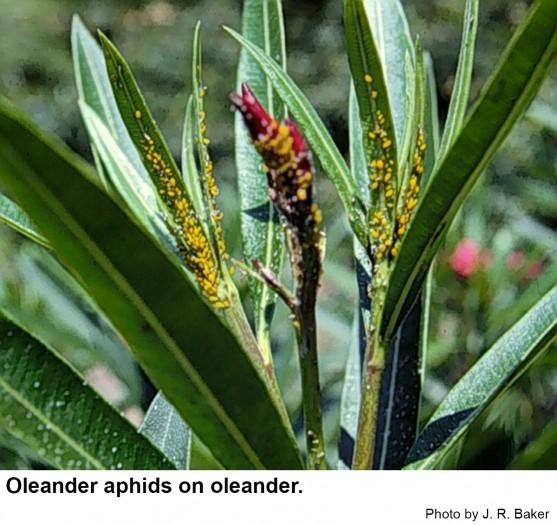Description and Biology
The oleander aphid, Aphis nerii, is a bright yellow aphid with black legs and antennae. It is often found on oleander in southeastern North Carolina and is found on butterfly weed throughout the rest of the state. It is also called the milkweed aphid. Oleander aphid populations often increase dramatically because they reproduce parthenogenetically and because the winged adults can migrate into new areas from time to time. Winged adults usually appear after a host plant becomes crowded or starts to decline. The oleander aphid is remarkable in that there is no male or egg stage. Females produce only nymphs that molt five times as the grow and mature, and they in turn produce only female nymphs. Their only excitement is the arrival of parasitic wasps, lady beetles, syrphid fly maggots, lace wings and other predaceous insects that feed on aphids and often decrease oleander aphid populations rapidly. Aphid are sometimes devastated by Cephalosporium lecanii, a fungus that infects aphids as a sort of deadly athlete's foot fungus.
Host Plants
Appropriately enough, the oleander aphid feeds on oleander, Nerium oleander, and also on vinca, which is in the same plant family. It also feeds on butterfly weed and scarlet milkweed, Asclepias spp, as well as wax plant, Hoya carnosa, that is also in the same family as milkweeds. Oleander aphids feed on sap sucked from the phloem tissue of plants through slender, threadlike mouthparts. They excrete honeydew, a sweet, sticky liquid. Sooty molds, dark fungi, grow in the honeydew so that infested plants are disfigured by the bright yellow aphids, their cast skins, sticky honeydew, and sooty molds. When oleander aphid populations are high, terminal growth may become deformed and overall plant growth stunted.
Residential Recommendation
Because ornamental plants are somewhat sensitive to pesticides, be sure to water plants thoroughly before spraying and to treat early in the morning or late in the evening so that the pesticide residue is dry before the plants are exposed to direct sunlight. Consider the use of an insecticidal soap or horticultural oil for control of aphids. Other pesticides labeled for aphids and home landscape use should give adequate control as well.
References
- Aphids on Ornamental Landscape Plants. Frank, S. 2019 (revised). Entomology Insect Notes, NC State Extension Publications.
- Common name: oleander aphid, scientific name: Aphis nerii Boyer de Fonscolombe (Insecta: Hemiptera: Aphididae). McAuslane, H. J. 2014 (reviewed). Entomology & Nematology, FDACS/DPI, EDIS, Publication Number: EENY-247.
- Horticultural Oils for Ornamental Plants. Frank, S. et al. 2018. Entomology Insect Notes, NC State Extension Publications.
- Sooty Molds. Frank, S. et al. 2019 (revised). Entomology Insect Notes, NC State Extension Publications.
- Extension Plant Pathology Publications and Factsheets
- Horticultural Science Publications
- North Carolina Agricultural Chemicals Manual
For assistance with a specific problem, contact your local N.C. Cooperative Extension Center.
This Factsheet has not been peer reviewed.
Publication date: Nov. 16, 2013
Revised: Oct. 9, 2019
Recommendations for the use of agricultural chemicals are included in this publication as a convenience to the reader. The use of brand names and any mention or listing of commercial products or services in this publication does not imply endorsement by NC State University or N.C. A&T State University nor discrimination against similar products or services not mentioned. Individuals who use agricultural chemicals are responsible for ensuring that the intended use complies with current regulations and conforms to the product label. Be sure to obtain current information about usage regulations and examine a current product label before applying any chemical. For assistance, contact your local N.C. Cooperative Extension county center.
N.C. Cooperative Extension prohibits discrimination and harassment regardless of age, color, disability, family and marital status, gender identity, national origin, political beliefs, race, religion, sex (including pregnancy), sexual orientation and veteran status.



-r180.jpg)
-r180.jpg)